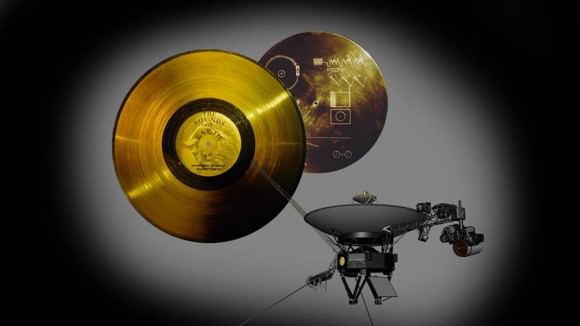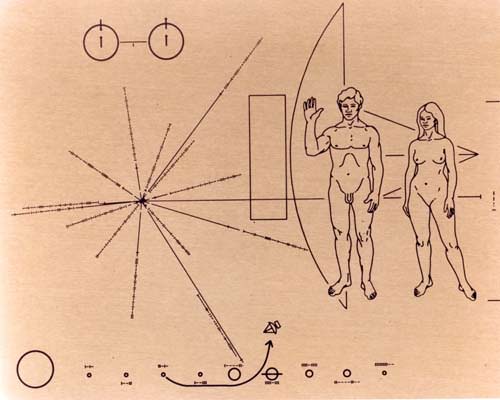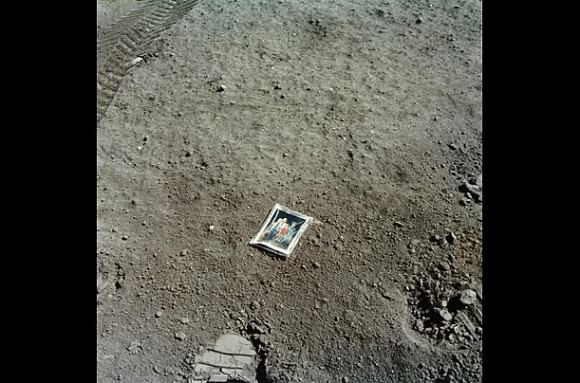
This image highlights the special cargo onboard NASA's Voyager spacecraft: the Golden Record. Each of the two Voyager spacecraft launched in 1977 carry a 12-inch gold-plated phonograph record with images and sounds from Earth. An artist's rendering of the Voyager spacecraft is shown at bottom right, with a yellow circle denoting the location of the Golden Record. The cover of the Golden Record, shown on upper right, carries directions explaining how to play the record, a diagram showing the location of our sun and the two lowest states of the hydrogen atom as a fundamental clock reference. The larger image to the left is a magnified picture of the record inside. Credit: NASA
Greeting cards in space… We’ve certainly sent our share of them, haven’t we? So if humankind is foresighted enough to leave messages of our whereabouts – and our personalities – in space, then why haven’t other alien civilizations done the same? That’s a question a pair of postdoctoral researchers at Penn State are asking. By using mathematical equations, they’re showing us we simply haven’t looked in enough places… and would we recognize an alien artifact even if it were staring us in the face?
“The vastness of space, combined with our limited searches to date, implies that any remote unpiloted exploratory probes of extraterrestrial origin would likely remain unnoticed,” report Jacob Haqq-Misra, Rock Ethics Institute, and Ravi Kumar Kopparapu, Earth and Environmental Systems Institute, in a paper accepted by Acta Astronautica and posted online on ArXiv.
So far, we simply haven’t found any evidence of alien artifacts in our solar system – or anywhere else for that matter. According to the Penn State article, the Fermi paradox, originally formulated by Enrico Fermi, asks, if intelligent life is common, why have no technological civilizations been observed. Well, shucks… Maybe they’re shy – and maybe they’ve self-annihilated. There are hundreds of reasons “why” we haven’t found anything, but the most pertinent answer is we simply aren’t looking for the right thing in the right place at the right time. For example, have a look at just a few of the things we humans have sent into vastness of space to act as our ambassadors…

Pioneer 10 and 11's famed Plaque features a design engraved into a gold-anodized aluminum plate, 152 by 229 millimeters (6 by 9 inches), attached to the spacecrafts' antenna support struts to help shield it from erosion by interstellar dust. Image Credit: NASA

Three LEGO figurines representing the Roman god Jupiter, his wife Juno and Galileo Galilei are shown here aboard the Juno spacecraft. Image credit: NASA/JPL-Caltech/KSC NASA's Jupiter-bound Juno spacecraft will carry the 1.5-inch likeness of Galileo Galilei, the Roman god Jupiter and his wife Juno to Jupiter when the spacecraft launches this Friday, Aug. 5. The inclusion of the three mini-statues, or figurines, is part of a joint outreach and educational program developed as part of the partnership between NASA and the LEGO Group to inspire children to explore science, technology, engineering and mathematics. Credit: NASA
And this is only just the tip of the human iceberg. How many of us have sent our name on missions to Mars, Pluto and more? There are footprints, plaques, flags, golf balls and an endless parade of human artifacts scattered far and wide. We might think they’re in plain sight, but would an alien culture see that? Would we comprehend what an alien culture might consider to be a greeting or sign or their presence? As far as we know, there could be unpiloted probes from alien civilizations out there right now, checking us out… But unless it were something the size of a proverbial school bus dropping itself on a house in Essex, our own arrogance would probably keep us from noticing it. And then again… it just might be hidden.
“Extraterrestrial artifacts may exist in the Solar System without our knowledge simply because we have not yet searched sufficiently,” said Haqq-Misra and Kopparapu. “Few if any of the attempts would be capable of detecting a 1 to 10 meter (3 to 33 foot) probe.”
Haqq-Misra and Kopparapu use a probabilistic method to determine the feasibility of aliens leaving us clues to their existence. Their work points to the Solar System as a fixed volume and then calculates the percentages of that volume that would need to be thoroughly searched to detect an alien probe or artifact. These searches would have to involve technology able to detect small, foreign objects and then apply it to a smaller portion of the volume to look for results. It’s a study which hasn’t been undertaken so far. We simply cannot say we’ve looked everywhere…
“The surface of the Earth is one of the few places in the Solar System that has been almost completely examined at a spatial resolution of less than 3 feet,” said Haqq-Misra and Kopparapu.
Sure. There are still a lot of nooks and crannies on Earth that haven’t been thoroughly explored – and our oceans are a good example. However, when it comes to searching elsewhere, it’s been a hit-or-miss proposition. While mapping the surface of the Moon, the Lunar Reconnaissance Orbiter is looking at the surface at a resolution of about 20 inches. It may take a few years, but perhaps something isn’t buried under the regolith. As for Mars, chances are slight – but new things seem to be discovered on Mars each day, don’t they? How about the LaGrange points, or the asteroid belt? Things could be hiding there, too.
“Searches to date of the Solar System are sufficiently incomplete that we cannot rule out the possibility that non terrestrial artifacts are present and may even be observing us,” said Haqq-Misra and Kopparapu. They add that “the completeness of our search for non terrestrial objects will inevitably increase as we continue to explore the Moon, Mars and other nearby regions of space.”
After all, what did we expect? E.T. to interrupt a prime time television program to announce their presence? A take-over of the Internet? Maybe each time a meteor makes it to Earth it’s a little calling card that life-possible organisms exists outside our own little sphere…
And maybe somebody needs to drop a bus on us.
Source: Universe Today

No hay comentarios:
Publicar un comentario